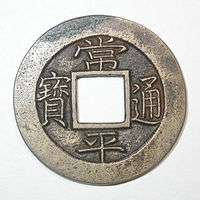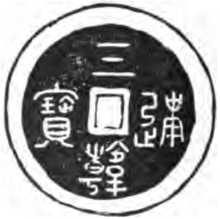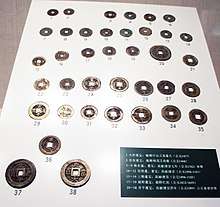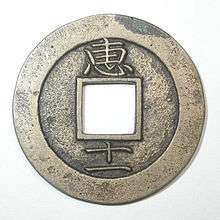Korean mun
| Korean mun | |
| Hangul | 문 |
|---|---|
| Hanja | 文 |
| Revised Romanization | mun |
| McCune–Reischauer | mun |


The mun was introduced as the main currency of Korea in 1633 and stayed in use until 1892. It resembled and was derived from the Chinese wen (cognate also to the Japanese mon, Ryukyuan mon, and the Vietnamese văn). Coins denominated in mun were cast in copper or bronze and were round with square holes. From the 17th century until the end of the 19th century, coins denominated in mun bearing the inscription Sangpyeong Tongbo (상평통보, 常平通寶) were the most widely circulated currency. In 1888, coins were struck in small numbers denominated in mun and won (equal to 1000 mun). The mun was replaced in 1892 when the yang was introduced.
History
Under Goryeo
_and_%EC%82%BC%ED%95%9C%EC%A4%91%EB%B3%B4_(%E4%B8%89%E9%9F%93%E9%87%8D%E5%AF%B6)_National_Museum_of_Korea.jpg)
The first definitive record of currency use in Korea appears in the Goryeo period (918–1392).[1] Early in that period, even though some imported Chinese currency from the Song, and Tang dynasties were in circulation, commodity currency such as grain and linen continued in general circulation. In the 10th and 11th centuries, iron and copper coins along with silver vase-shaped coins were issued, but never widely circulated.[2]
King Sukjong of Goryeo created a new monetary system based on round copper coins with square holes as well as the unbyŏng (銀瓶, 은병) shaped like the Korean peninsula. The coins were produced bearing the inscriptions 東國 (동국/Dong guk or "Eastern Country"), 海東 (해동/hae dong or "Eastern Sea"), and 三韓 (삼한/Samhan).[3]
An extremely rare variant of the Samhan Tongbo (삼한통보, 三韓通寶) coin exists that bears the character 叁 written in "official script" instead of 三, of which only 2 have currently been found.[3]
| Inscription | Hangul | McCune–Reischauer | Revised Romanisation | Scripts | Date of casting | Image |
|---|---|---|---|---|---|---|
| 東國通寶 | 동국통보 | Dong kuk T'ong Bo | Dong Guk Tong Bo | Seal script (篆書), Clerical script (隸書), Regular script (楷書), and Running script (行書) | 998-1097 AD | |
| 東國重寶 | 동국중보 | Dong Kuk Chung Bo | Dong Guk Jung Bo | Regular script (楷書) | 998-1097 AD |  |
| 三韓通寶 | 삼한통보 | Sam Han T'ong Bo | Sam Han Tong Bo | Seal script (篆 書), Clerical script (隸書) and Running script (行書) | 1097-1105 AD |  |
| 叁韓通寶 | 삼한통보 | Sam Han T'ong Bo | Sam Han Tong Bo | "Official Script" | 1097-1105 AD | |
| 三韓重寶 | 삼한중보 | Sam Han Chung Bo | Sam Han Jung Bo | Regular script (楷書) | 1097-1105 AD |  |
| 海東通寶 | 해동통보 | Hae Dong T'ong Bo | Hae Dong Tong Bo | Seal script (篆書), Clerical script (隸書), Regular script (楷書), and Running script (行書) | 1097-1105 AD |  |
| 海東重寶 | 해동중보 | Hae Dong Chung Bo | Hae Dong Jung Bo | Regular script (楷書) | 1097-1105 AD | |
| 海東元寶 | 해동원보 | Hae Dong Wŏn Bo | Hae Dong Won Bo | Regular script (楷書) | 1097-1105 AD |
Early Joseon
_National_Museum_of_Korea.jpg)
It was not until the beginning of the Joseon period (1392–1910) that copper coins were minted for wide circulation. Jeohwa (저화/楮貨), which was made of standardized mulberry-bark paper early in the Joseon period, become the first legal paper money and was used as a medium of exchange in place of coins until it disappeared in the early 16th century.
Bronze coins were cast starting in 1423 during the reign of king Sejong the Great in 1423 with the Joseon Tongbo (조선통보, 朝鮮通寶), and Shibjeon Tongbo (십전통보, 十錢通寶) coins.[4][3] The coins produced under Sejong were pegged to silver at 150 coins to one Kŭn (斤, 근) which is equal to 600 grams, though the actual market rates regularly fluctuated. But the monetary system proved to be unpopular as people resorted back to barter after a few years.
In 1625 under the reign of king Injo of Joseon new coins with the same inscription as under Sejong the Great were minted, these coins became the inspiration for the following Sangpyeong Tongbo series, though later these coins would be suspended due to the Later Jin, and the Qing invasions of Joseon. After those wars Korea would become dependent on importing copper from Japan in order to sustain the production of coinage.[5]
Sangpyeong Tongbo coins

Coins issued by a government famine relief organisation named the "Stabilization Office" (Sangpyeongchong 상평청, 常平廳) were introduced in 1633, the coins bear an abbreviation of the office's name with the phrase Tongbo (통보/"通寶" or circulating treasure) together formulating the inscription Sangpyeong Tongbo (상평통보, 常平通寶) which could be interpreted as "always even currency".[3] These coins started to circulate all over Joseon in 1678 during the reign of king Sukjong of Joseon.
Unlike earlier minted coins from the Georyo period, no mun currency produced under the Joseon dynasty bore the inscription Jungbo (元寶, 원보) on any large denomination because a Chinese naming taboo where the character "元" (Hangul: 원) may not be used as it was a part of Hongwu's original name, the founding emperor of the Ming Dynasty, of which Joseon was a tributary state. For this reason even all 100 mun coins also bear the inscription of "常平通寶", giving every coin from this period exactly the same observe.
As records weren't actively kept it's currently unknown how many different variants were cast, and how much of each respective denomination (with the notable exception of the 100 mun coin, of which a total of 1,784,038 were minted).[6] There are 3,078 varieties of the 1, 2, and 5 Mun denominations, and 48 varieties of the 100 Mun denomination documented by the authoritative Korean coin catalogue (Hanja: 高麗朝鮮時代貨幣; Hangul: 고여조선시대화폐), while there are estimated more than 5,000 different variants of the Sangpyeong Tongbo coins cast in the history of its production spanning 258 years, with many variants of the series still undocumented.
| Denomination | Hanja | Hangul | Diameter (in millimeter) | Dates | Notes |
|---|---|---|---|---|---|
| 1 mun | 一文 | 일문 | 24-25 | 1633 | |
| 2 mun | 二文 | 이문 | 27-29 | 1679 | |
| 5 mun | 五文 | 오문 | 31-33 | 1883 | Contains the inscription "當五錢" (당오전). |
| 100 mun | 百文 | 백문 | 40.6 | 12 December 1866 (Date of first mint by the Treasury Department of the Joseon government.) 15 January 1867 (Date that circulation among the general populace began.) 16 June 1867 (Date that the production of these coins by the government of Joseon had ceased.) | 100 mun coins are the only accurately documented denomination of which records exist. All of the government produced 100 mun coins always had a thickness of 2.8 millimeter and a weight of 25.1 grams. These coins were produced a total of 172 days from the date of first production to their discontinuation. |
100 mun coin and inflation
When the 100 mun denomination (Tangbeakjeon, 當百錢/당백전) was introduced in 1866 by regent Heungseon Daewongun to finance the state's military expenditures the mun started to suffer from inflation, this was because the intrinsic value of the 100 mun coin was only five to six times as much as 5 mun coins, leading to the consumer price of e.g. rice to expand sixfold within 2 years. This eventually lead to traders preferring silver foreign currency such as the Mexican peso, Japanese yen, Russian ruble, and Chinese sycees.
The introduction of the 100 mun coin happened concurrent with the Tenpō Tsūhō 100 mon coin issued by the Tokugawa shogunate in 1835 (in reaction to government deficit),[7] and the 100 wén coin by the Qing dynasty in 1853 (in reaction to the Taiping rebellion).[8] Both of these coins also caused inflation on comparable levels.
After king Gojong of Joseon established the Jeonwanguk mint in 1883 in Incheon in order to adopt a currency more akin to international standards leading the copper Sangpyeong Tongbo coins to eventually be phased out in favour of the silver yang.[5][9][10]
Mint marks

Originally the Stabilization Office or the Sangpyeongchŏng (상평청, 常平廳) was the first agency to mint Sangpyeong Tongbo coins in 1633, and eventually various other government agencies (including military offices, and the Six Ministries of Joseon) began to produce these coins which contained various mint marks to establish their origin.[3] At the time the mun was replaced by the yang in 1892 there had been 52 government mints in operation producing mun coins locally.[11]
| Mint mark | Hangul | Name of the agency in Hanja | Name of the agency in Hangul | Romanised | Name in English | Year introduced | Image |
|---|---|---|---|---|---|---|---|
| 戶 | 호 | 戶曹 | 호조 | Hojo | Treasury Department | 1678 |  |
| 工 | 공 | 工曹 | 공조 | Kongjo | Ministry of Industry | 1685 | |
| 均 | 균 | 均役廳 | 균역청 | Kyunyokchong | Government Tithe Office | 1807 | |
| 司 | 사 | 司仆寺 | 사부사 | Kyong Saboksi | Bureau of Royal Transportation | 1678 | |
| 賑 | 진 | 賑恤廳 | 진휼청 | Chinhyulchong | Charity Office in Seoul | 1742 | |
| 向 | 향 | 粮餉廳 | 량향청 | Yanghyangchong | Food Supply Office | 1742 | |
| 宣 | 선 | 宣惠廳 | 선혜청 | Sonhyechong | Rice and Cloth Department | 1742 | |
| 惠 | 혜 | 宣惠廳 | 선혜청 | Sonhyechong | Rice and Cloth Department | 1806 |  |
| 典 | 전 | 典圜局 | 전원국 | Chonhwanguk | Central Government Mint | 1833 | |
| 兵 | 병 | 兵曹 | 병조 | Pyongjo | Ministry of Military Affairs | 1742 | |
| 備 | 비 | 備邊司 | 비변사 | Pibyonsa | National Defense Bureau | 1742 | |
| 捻 | 염 | 捻戎廳 | 염융청 | Chongyungchong | General Military Office | 1692 | |
| 营 or 營 | 영 | 御营廳 | 어영청 | Oyongchong | Special Army Unit | 1678 | |
| 武 (1) | 무 (1) | 武備司 | 무비사 | Mubisa | Armaments Bureau | 1742 | |
| 武 (2) | 무 (2) | 武衛營 | 무위영 | Muwiyong | Guard Office at the Palace | 1742 | |
| 禁 | 금 | 禁衛營 | 금위영 | Kumwiyong | Court Guard Military Unit | 1742 | |
| 訓 | 훈 | 訓練都監 | 훈연도감 | Hullyondogam | Military Training Command | 1678 | |
| 抄 | 초 | 精抄廳 | 정초청 | Chongchochong | Commando Military Unit | 1678 | |
| 統 (1) | 통 (1) | 統營 | 통영 | Tongyŏng | Tongyeong Naval Office | 1727 | |
| 統 (2) | 통 (2) | 統衛營 | 통위영 | Tongwiyong | Military Office in Seoul | 1727 | |
| 經 | 경 | 經理廳 | 경리청 | Kyŏngnichong | Government Office of Pukhan Mountain Fortress | 1830 | |
| 守 | 수 | 守御廳 | 수어청 | Suochong | Seoul Defense Fort | 1742 | |
| 沁 | 심 | 沁華管理 | 심화관이 | Sim Kanghwa Kwalliyong | Kanghwa Township Military Office | 1883 | |
| 開 | 개 | 開城管理營 | 개성관이영 | Kaesong Kwalliyong | Kaesong Township Military Office | 1678 | |
| 松 | 송 | 開城管理營 | 개성관이영 | Kaesong Kwalliyong | (Song) Kaesong Township Military Office | 1882 | |
| 利 | 리 | 利原管理營 | 리원관이영 | Iwon Kwalliyong | Iwon Township Military Office | 1882 | |
| 水 | 수 | 水原管理營 | 수원관이영 | Suwon Kalliyong | Suwon Township Military Office | 1727 | |
| 原 | 원 | 原州管理營 | 원주관이영 | Wonju Kwalliyong | Wonju Township Military Office | 1678 | |
| 海 | 해 | 海州管理營 | 해주관이영 | Haeju Kwalliyong | Haeju Township Military Office | 1742 | |
| 春 | 춘 | 春川管理營 | 춘천관이영 | Ch'unch'on Kwalliyong | Ch'unch'on Township Military Office | 1888 | |
| 川 | 천 | 端川管理營 | 단천관이영 | Tanch'on Kwalliyong | Tanch'on Township Military Office | 1883 | |
| 昌 (1) | 창 (1) | 昌德宮 | 창덕궁 | Ch'angdŏk Kung | Ch'angdŏk Palace Mint | 1864 | |
| 昌 (2) | 창 (2) | 昌原管理營 | 창원관이영 | Ch'angwon Kwalliyong | Ch'angwon Township Military Office | 1864 |  |
| 圻 | 기 | 廣州管理營 | 광주관이영 | Kwangju Kwalliyong | Kwangju Township Military Office in Kyonggi Province | 1742 | |
| 京 | 경 | 京畿監營 | 경기감영 | Kyŏnggi Kamyong | Kyŏnggi Provincial Office | 1742 | |
| 京 水 | 경수 | 京畿水營 | 경기수영 | Kyŏnggi Suyong | Kyŏnggi Naval Station | 1742 | |
| 黃 | 황 | 黃海監營 | 황해감영 | Hwanghae Kamyong | Hwanghae Provincial Office | 1742 | |
| 平 | 평 | 平安監營 | 평안감영 | P'yŏngan Kamyong | P'yŏngan Provincial Office | 1678 | |
| 平 兵 | 평병 | 平安兵營 | 평안병영 | P'yŏngan Pyongyong | P'yŏngan Military Fort | 1678 | |
| 咸 | 함 | 咸鏡監營 | 함경감영 | Hamgyong Kamyong | Hamyong Provincial Office | 1742 | |
| 咸 北 | 함북 | 咸鏡北營 | 함경북영 | Hamgyong Pugyong | North Hamyong Provincial Office | 1742 | |
| 咸 南 | 함남 | 咸鏡南營 | 함경남영 | Hamgyong Namyong | South Hamyong Provincial Office | 1742 | |
| 江 | 강 | 江原監營 | 강원감영 | Kangwon Kamyong | Kangwon Provincial Office | 1742 | |
| 尚 | 상 | 慶尚監營 | 경상감영 | Kyongsang Kamyong | Kyongsang Provincial Office | 1695 | |
| 尚 水 | 상수 | 慶尚水營 | 경상수영 | Kyongsang Suyong | Kyongsang Naval Station | 1695 | |
| 尚 右 | 상우 | 慶尚右營 | 경상우영 | Kyongsang Uyong | Kyongsang Right Naval Base | 1695 | |
| 尚 左 | 상좌 | 慶尚左營 | 경상좌영 | Kyongsang Chwayong | Kyongsang Left Naval Base | 1695 | |
| 全 | 전 | 全羅監營 | 전라감영 | Chŏlla Kamyong | Chŏlla Provincial Office | 1682 | |
| 全 兵 | 전병 | 全羅兵營 | 전라병영 | Chŏlla Pyongyong | Chŏlla Military Fort | 1678 | |
| 全 右 | 전우 | 全羅右營 | 전라우영 | Chŏlla Uyong | Chŏlla Right Naval Base | 1678 | |
| 全 左 | 전좌 | 全羅左營 | 전라좌영 | Chŏlla Chwayong | Chŏlla Left Naval Base | 1678 | |
| 忠 | 충 | 忠清監營 | 충청감영 | Ch'ungch'ŏng Kamyong | Ch'ungch'ŏng Provincial Office | 1742 |
Various other symbols to identify specific coins were also used such as the Thousand Character Classic, "furnace" and "series" numbers, as the Five Elements, astronomical symbols, the Eight Trigrams, the Ten Celestial Stems, the Twelve Terrestrial Branches, as well as a variety of characters with an unknown purpose. Mint marks were placed above the square hole on the reverse site, while furnace markings and other Chinese characters were placed below, special symbols such as dots, circles, crescents, horizontal lines, and vertical lines generally appeared either left or right of the square hole.[3]
With the notable exception of the coins produced by the Government Office of Pukhan Mountain Fortress which bears the character "Kyŏng" (經/경) written in Running script, all Hanja characters on both sides of every Sangpyeong Tongbo coin are written in regular script. Though the character "通" (통) only contains one dot which is a characteristic of Clerical script as Regular script versions usually have 2 dots.
See also
References
- ↑ A New History of Korea by Ki-baik Lee (Harvard University Press, 1984; p 122).
- ↑ "Monetary History of Korea". Armstrong Economics (Researching the past to predict the future). 10 April 2012. Retrieved 8 June 2017.
- 1 2 3 4 5 6 "Korean Coins – 韓國錢幣 - History of Korean Coinage". Gary Ashkenazy / גארי אשכנזי (Primaltrek – a journey through Chinese culture). 16 November 2016. Retrieved 5 June 2017.
- ↑ Bank of Korea – Money Museum Currency of the Goryeo and Joseon Dynasty Retrieved: 9 June 2017.
- 1 2 "[Weekender] Korean currency evolves over millennium". Chang Joowon (The Korean Herald – English Edition). 28 August 2015. Retrieved 7 June 2017.
- ↑ Numis Coins of the Month Member's Coin of the Month Gallery: Korea - "Charmed" 100 Mun ~ 1866 Access date = 8 June 2017.
- ↑ TAKIZAWA Takeo, (1996) Nihon no Kahei no Rekishi (History of Japanese Currencies) Tokyo, Yoshikawa Kobunkan. (Takizawa p.242).
- ↑ PENG Xin-Wei, (1958) Zhongguo Huobi Shi (Monetary History of China), second ed., Shanghai, Shanghai Renmin Chubanshe, (Peng pp.833-838).
- ↑ XIV International Economic History Congress, Helsinki 2006 Session 106 Too Commercialised To Synchronize Currencies: Monetary Peasant Economy in Late Imperial China in Comparison with Contemporary Japan by Akinobu Kuroda (University of Tokyo) Retrieved: 11 June 2017
- ↑ LEE Seok-Ryun (1984) Hanguk Hwapye Geumyungsa Yeongu (Study of Monetary and Financial History of Korea), Seoul, Pakyoungsa. (Lee p.123.)
- ↑ Creounity Time Machine (Dating. History. Written Language) Brief historical review. Decline of the joint Korean Empire. Coin denominations Andrey Tretyakov Access date = 8 June 2017.
Sources
- Kurt Schuler (2004-02-29). Tables of modern monetary history: Asia. Currency Boards and Dollarization.
- Wybrand op den Velde and David Hartill (12 November 2013) Cast Korean Coins and Charms. New Generation Publishing. ISBN 978-0755215942.
- Alan D. Craig, and Mario L. Sacripante. The Coins of Korea and an Outline of Early Chinese Coinages. Publisher: Ishi Press International. Published: 5 April 2011. ISBN 4871878953
External links
| Preceded by: No modern predecessor |
Currency of Korea ? – 1892 Concurrent with: Chinese currencies |
Succeeded by: Korean yang Reason: currency reform |
| Wikimedia Commons has media related to: |
.jpg)